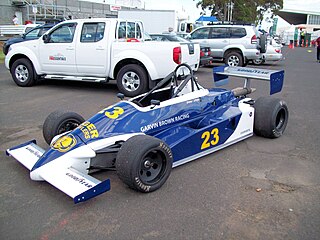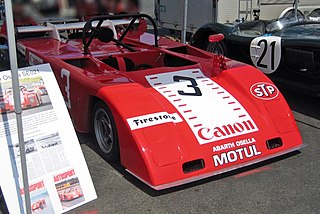
The Ferrari 250 GTO is a GT car produced by Ferrari from 1962 to 1964 for homologation into the FIA's Group 3 Grand Touring Car category. It was powered by Ferrari's Tipo 168/62 Colombo V12 engine.

Spice Engineering was a British racing team founded by driver Gordon Spice with Raymond Bellm in the early 1980s, later becoming a successful sports car constructor in 1986. They competed in the World Sportscar Championship in Europe as well as the IMSA GT Championship in North America, at times partnering with major manufacturers such as General Motors and Honda as well as race engine manufacturer Comptech.

The Chevrolet Corvette GTP was an American Grand Touring Prototype-class sports prototype racing car which successfully participated in the IMSA Camel GT from 1984 until 1989. The car was professionally fielded in competition as General Motors' Chevrolet Corvette C4 official factory team effort in the IMSA GTP class.

Tiga Race Cars Ltd. was a British auto racing constructor and team. The company was founded in 1974 by two former Formula 1 drivers, Australian Tim Schenken and New Zealander Howden Ganley. The company's name was formed by the first two letters of Tim and Ganley. Tiga constructed racing cars for various forms of open wheel racing and sports car racing, ranging from Formula Ford to the World Sportscar Championship.
Embassy Racing was a British auto racing team founded by Jonathan France in 2003. Initially created as a conjunction with Xero Competition in the British GT Championship, the team expanded to become an independent team and began to win races in British GT before the team took a sabbatical year in 2006. Upon their return to motorsport, Embassy moved to the international Le Mans Series, running in a Le Mans Prototype class, as well as entering the British Superbike Championship's junior leagues, the Supersport and Superstock Championships, running with the support of Triumph Motorcycles under the MAP Embassy Triumph banner.
The Tiga GC84, also known as the Tiga GC284, is a sports prototype race car, designed, developed, and built by British manufacturer Tiga Race Cars, for sports car racing, conforming to the Group C1/C2 rules and regulations, in 1984.
The Lamborghini Countach QVX, occasionally referred to as the Lamborghini QVX, was a short-lived Group C sports racing car built in 1985. It was not built or designed by the Lamborghini factory, but instead used a Spice Engineering-built chassis and an engine derived from the Lamborghini Countach's V12. Lamborghini's British importer commissioned the car. Financial issues restricted it to one race, despite numerous entries in 1986 and a handful in 1987, but its one race showed the car had potential.

The Lola Mk1 is the first sports racing car made by Lola, under the leadership and guidance of Eric Broadley, in 1958. The body was designed and developed by chief stylist Maurice Gomm, made out of a steel or fiberglass tubular spaceframe chassis, covered in a low-profile, sleek, aluminum skin. The 80 hp (60 kW), 1,098 cc (67.0 cu in), Coventry Climax FWA four-cylinder engine was designed by Harry Mundy and Walter Hassan. The car used a 4-speed manual transmission, and was lightweight, only weighing in at a mere 812–840 lb (368–381 kg). It also notably won its class at the 1960 12 Hours of Sebring, being driven by Charles Vögele and Peter Ashdown. At least 32 cars were known to have been built, but the actual number is believed to be between 38 and 42.

The Abarth-Osella 2000 Sport SE-021 is a mid-engined, Group 5, prototype race car, built by Osella to compete in the World Sportscar Championship sports car racing series in 1972, and for some races in 1973. The chassis itself was developed and developed by Osella, while the car itself was powered by a 2.0 L (120 cu in) Abarth four-cylinder engine, generating a healthy 265 hp (198 kW). Since the light and nimble chassis only weighed 530 kg (1,170 lb), this gave it an incredible power-to-weight ratio.
The Osella PA2 is a 2-liter Group 5 prototype racing car built by Osella, to compete in the World Sportscar Championship sports car racing series from 1974 to 1975, but was used in active competition IMSA GT Championship until the end of 1985. It was initially powered by either the 2.0 L (120 cu in) Abarth twin-cam engine, or later, the BMW M12/7 Turbo engine.

The Osella PA3 is a Group 6 prototype racing car designed, developed, and built by Osella, to compete in the World Sportscar Championship sports car racing series in 1975, but was used in active competition through 1986. It was powered by a number of different engines, including the 2.0 L (120 cu in) BMW M12/7, the Abarth twin-cam engine, and the Cosworth BDG, or the 1.3 L (79 cu in) Cosworth BDH, or even the smaller the smaller 998 cc (60.9 cu in) Cosworth SCA. The 1.6 L (98 cu in) and 1.8 L (110 cu in) Cosworth FVA and Cosworth FVC were also used. It was even powered by a Ferrari 2.0 V8 engine.

The Ferrari 712P is a purpose-built Group 7 prototype, designed, developed and built by Scuderia Ferrari specifically designed to compete Can-Am sports car races from 1970 to 1974. The 7 refers to the displacement of the engine in liters, the 12 refers to the number of cylinders, and the P stands for Prototype.

The March 84G was a mid-engined Group C and IMSA racing sports prototype, designed and developed by March Engineering in late 1983 and used in sports car racing until 1989. It was powered by a number of different engines, including a Chevrolet small-block, a Buick V6, a Porsche flat-six, and even a Mazda 13B Wankel rotary engine. Power output was around 620 hp (460 kW). It only managed to score 5 wins, and clinch a total of 10 podium, over the course of 7 years and 119 race entries.

The Brabham BT5, and its evolution, the Brabham BT8, are sports racing cars manufactured and developed by Brabham in 1963 (BT5) and 1964 (BT8), respectively. It won a total of 4 races, and achieved 10 podium finishes.

The Tiga GC287 is a sports prototype race car, designed, developed, and built by British manufacturer Tiga Race Cars, for sports car racing, conforming to the Group C2 rules and regulations, in 1987.
The Tiga GC285, also known as the Tiga GC85, is a sports prototype race car, designed, developed, and built by British manufacturer Tiga Race Cars, for sports car racing, conforming to the Group C2 rules and regulations, in 1985.
The 'Tiga GC83 is a sports prototype race car, designed, developed, and built by British manufacturer Tiga Race Cars, for sports car racing, conforming to the Group C1/C2 rules and regulations, in 1983.
The Tiga GC288 is a sports prototype race car, designed, developed, and built by British manufacturer Tiga Race Cars, for sports car racing, conforming to the Group C2/IMSA GTP Lights rules and regulations, in 1988.
The Tiga GC289 is a sports prototype race car, designed, developed, and built by British manufacturer Tiga Race Cars, for sports car racing, conforming to the Group C2/IMSA GTP Lights rules and regulations, in 1989.
The Tiga GT286 is a sports prototype race car, designed, developed, and built by British manufacturer Tiga, for sports car racing, conforming to Group C2 and IMSA GTP Lights rules and regulations, in 1986, and continued competing until 1993.











